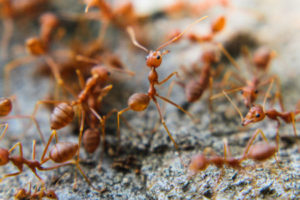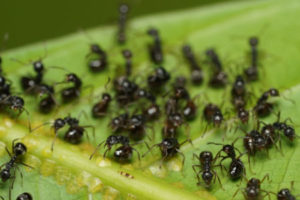when ants get sick
By Zachary Ciras on August 16, 2022.
Humans are not the only species who are vulnerable to illness. In fact, humans are not alone in acknowledging the presence of infectious pathogens in our individual members. Furthermore, humans are not the only species with plans on how to deal with pathogens before they break out into epidemics or pandemics. Other species, including those in the order Hymenoptera (bees, wasps, ants) have prophylactic methods of dealing with disease as well as emergency response when a virus or other pathogen is threatening to be introduced.
If you’ve read any research papers or written any for advancing your education, you can almost bet that the findings will be that more research is needed. In the case of pathogen response in Hymenoptera, more research has definitely been needed. In the past several years, some biologists and entomologists have taken up the cause and begun to publish their findings. Among their research subjects have been various ant species. These 6 legged laboratory specimens and their ilk are helping scientists to develop a better understanding of insect reaction to illness and to use this information to improve human flourishing.
Eusociality
Eusociality is the highest level of organizing society. Some mammals are eusocial, such as certain mole-rats, and some crustaceans. Most eusociality is observed in insects, especially in termites (Isoptera) and in Hymenoptera (Ants, bees, and wasps). Eusocial animals are characterized in part by their cooperation, even in caring for the broods from other individuals, overlapping generations of adults, and a clear division of labor, separating reproductive and non-reproductive castes. Often, communication in eusocial communities is characterized by grooming each other, and passing pheromones throughout the colony. This close-knit community way of living would not fit into the guidelines of social distancing, quarantine, and isolation. This means of living and communicating make eusocial animals such as ants vulnerable to pathogens infecting the entire colony. Early detection of sick individuals has been observed in some ant colonies. How the colony deals with the pathogen carrying individuals is not consistent, but provides some insight into the seriousness with which these ants take infectious disease.
Prescriptive Defense

Red imported fire ant
Despite the vulnerabilities of ants colonies when coming into contact with pathogens, colony elimination due to these infections are not common. Valerie Renee Holmes and other researchers from Texas A&M have been focusing on viral invaders related to the red imported fire ant, Solenopsis invicta. When the COVID-19 pandemic swept through, Ms. Holmes was able to focus on her dissertation. Honey bees (Apis mellifera) are also in focus for her, showing the potential use of pathogenetic control to reduce problematic ants and to strengthen at-risk honey bee colonies before they collapse. These twin focuses have major economic impact, both in minimizing invasive ants, and in food production related to bees. Her research demonstrates in part a gatekeeper system, with an individual stationed at the entrance to detect and disallow infected insects from entering the nest and putting otherwise healthy ants or bees in jeopardy. This social immunity is a behavioral adaptation or modification. Other behavioral adaptations may be the application of certain antimicrobial chemicals released from the insects, such as honey bee venom which seems to serve as an antiseptic. She reports the use of grooming to remove parasites, utilizing “social fever” to heat and kill bacteria, and up taking resins to prophylactically reduce infection. Antimicrobial peptides have also been identified in Hymenoptera, and may prove to be an important area of research going forward. These are just a few areas of research displaying the group abilities to prevent and remove potentially harmful pathogens from ant and bee colonies. Research thusfar primarily done with flies indicates more biological systems such as RNAi, Toll pathways, and JAK/STAT protein systems having roles in a healthy colony. The paper goes into some depth, but also serves as a pleas for further research on these vital topics.

The black garden ant, also known as the common black ant, is a formicine ant, the type species of the subgenus Lasius
Another laboratory now operating out of the University of Bristol, England has been doing research studying pathogenetic response in black garden ants. Nathalie Stroeymteyt and her team actually had their lab all but shut down with the onset of COVID sweeping through Europe. She has published a number of interesting papers, including research related to the black garden ant pathogenic response. She found that the social distancing engaged in with humans had an ant analog. This concurs with the “gatekeeper” behavior noted above. Her research also indicates the importance of hygiene, removal of dead individuals from the nest, grooming and trophallaxis serving as a vaccination of sort, and expulsion of cannibalism of suspect individuals for the protection of the colony. She has a number of her papers listed on her website.
Potential Human Impacts
The relationship this research will have on human reactions to potential pathogenic threats, whether viral, bacterial, or other is yet to be seen. On a large scale, we may learn what approaches work for Hymenoptera and how we can use these in our response. On a more immediately practicable scale, by learning how eusocial biological organisms best prevent and eradicate invasive pathogens, we may be able to protect vulnerable colonies of honey bees, for example, and reduce the colony collapse issues so many are watching. We may be able to use this information in pest control, to better target our invasive ant species who cause economic damage. The field of research on this still seems quite young, so the overall benefits may be slow to come, and they may not be benefits we are thinking of as of yet. Any way, the research which has already occurred tells us that there’s something to learn there. More research is needed.